BY BARBARA NELLES
Parents tell their children, “It’s what’s on the inside that counts.”
In the mattress industry, that adage only exacerbates the sibling rivalry between suppliers of innersprings and their counterparts offering foams. Each wants to be at the center—the center of attention in the industry and the actual center of the mattress.
With the popularity of all–foam bedding growing, the competition between the two segments is heating up, as BedTimes discovered when speaking with a number of foam and springs suppliers around the world.
Yet the relationship isn’t all adversarial. In recent years, the two components have demonstrated an ability to get along quite well when paired in hybrid mattresses.
“It’s important that you find a balance between the importance of the innerspring unit and the need for ‘sexier’ components like visco and latex,” says Rick Anthony, director of sales for bedding products for Hickory Springs Mfg. Co. in Hickory, N.C.
Perhaps innerspring supplier Subiñas has struck the perfect balance.
“We have learned to work with foams,” says Javier Subiñas, president of the Vizcaya, Spain–based company. As an example, the company ships preassembled and glued foam–encased Bonnell and Marshall coil units complete with foam upholstery layers.
Regardless of rivalries or accords, there is no question that each is vital to mattress construction. On the following pages, BedTimes looks at significant trends and innovations in both categories, as well as what’s happening with a new component sibling—gel.
Focused on feature-filled foams
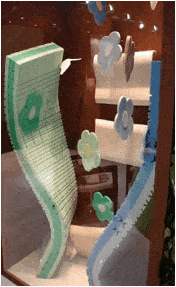
Orsa Foam has rolled out bio–based BB Foam. The company, headquartered in Gorla Minore, Italy, says the foams have 34% to 41% total plant–based content.
Foam suppliers BedTimes spoke with expressed delight at the continued growth of the specialty sleep mattress category around the world. Several latex and polyurethane foam producers said their primary focus has shifted from sales of upholstery layer components to promoting all–foam constructions.
“The European concept of what we call ‘engineered’ foam cores—multilayered with comfort foams on top and support foams on the bottom, in different cutouts, convolutions and profiles—is growing in popularity in the U.S.,” says Ed Malechek, president of Carpenter Co., based in Richmond, Va.
“Foam is the sleep of the future,” says Bob Steelman, vice president of sales and marketing at Carpenter. “In our bedding lab in Richmond, we worked with Sealy to design the engineered cores in the Embody bed. It’s a testament to ‘foam sleep’ that Sealy chose to get involved with it.”

To create this core, Paris–based Sapsa Latex pours latex around horizontal rods of polyurethane foam of differing densities.
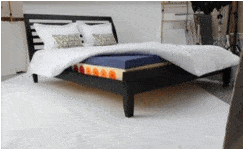
Carpenter Co. in Richmond, Va., offers Active Air hole–punch technology to dissipate heat and improve breathability in visco–elastic foam comfort layers (shown in the blue) and cores.
“We offer an entire catalog of special foams for mattresses,” says Rita Kollbrunner, head of marketing and communications for FoamPartner Group, a division of Fritz Nauer AG in Wolfhausen, Switzerland. “But we also design and propose specific mattress constructions for customers. It’s a service we provide to manufacturers of all sizes.”
Flexible Foam completely preassembles foam cores and comfort layers for customers but also creates “foam pockets” that are ready to accept encased coils or other components and upholstery layers—and ships them all to customers, ready for use, says Michael Crowell, vice president of marketing for the company, which has headquarters in Spencerville, Ohio.
“The flexibility and versatility of foam allows us to address all sorts of issues,” Steelman says. “We have 20 types of visco–elastic foam. Our Active Air hole–punch technology for cores and comfort layers was developed in response to the heat and breathability issues with foam. All of our plants now have the computerized cutting equipment to produce engineered cores and Active Air technology.”
Special blends, cuts & colors
Growing trends in foams include custom blends made to customer specifications and new ingredients mixed into the foam, as well as topical coatings applied after the foam is poured and set. There are new polyurethane and latex foam offerings that include anti–bacterial silver, gels, active carbon for odor control, FR coatings and essential oils.
Sometimes the extra ingredient in a foam is color.
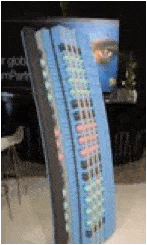
FoamPartner Group, with headquarters in Wolfhausen, Switzerland, adds color to its foams to differentiate their properties.
“Adding color to foams can add drama and an identity to the different foams, making them easier to market,”
Kollbrunner says.
Retailers and consumers may not be able to see color–differentiated foams in the finished mattress, but the variety of hues can be highlighted in point–of–purchase materials—from posters to cutaways—to better explain the properties and functions of various foams.
Ticking producers have been adding scents to fabrics for years and fragrances are now making their way into foams, sometimes coordinated with color. One FoamPartner customer requested a lavender–colored core that was embedded with lavender–scented “pearls.”
Polyurethane and memory foams have been around for a long time, Crowell says: “Next–generation foams are all about what you are combining with them. In our lab, we are experimenting with many things.” For now, Crowell is mum about the details of what those many things might be, but says mattress makers should look for new developments later this year.
Some European foamers speak of moving beyond memory foam, which, as Kollbrunner says, has become a commodity product in many ways.
FoamPartner has introduced EvoPoreHRC, which it markets as “a material for modern people.” The company says the product is a lighter weight, high–resiliency foam that offers “stability, support, moisture wicking, elasticity and climate regulation.”
In rolling out innovations, foam suppliers are trying to keep up with mattress manufacturers who are looking for new features and novelties, says Isabella Mariani, director of sales for Gommagomma.
The foam producer, which is based in Caronno Pertusella, Italy, touts a highly breathable, high–density polyurethane foam called WaterGel, which “gives manufacturers a new story to tell.”
“It’s not about the same old latex or memory foam. It’s a very breathable, extreme open–cell foam,” Mariani says.
Creating exclusive foams for customers is an important focus for Hickory Springs.
“We entered the bedding foam category about nine years ago and our home runs have been driven by specific innovation for specific customers and we continue to work in that direction,” says David Duncan, vice president of the Western Foam Division at Hickory Springs Mfg. Co. in Hickory, N.C. “Scientists from our wet lab consult with customers’ R&D departments, which are often looking for unique foams with specific conforming qualities, breathability, air flow, heat dissipation and other properties. We’re constantly developing new products for customers, much as we developed NxG Advanced Memory Foam for Simmons.”
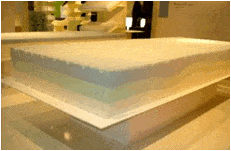
Gommagomma, based in Caronno Pertusella, Italy, topped this engineered foam mattress with its new WaterGel, a breathable, high–density polyurethane foam.
‘Green’ talk
In recent years, foamers have introduced polyurethane foams that replace a portion of the petroleum–based content with bio–based ingredients such as soy. Other foam suppliers make it a priority to be “green” in different ways—reducing their carbon footprints by re–engineering their products and operational processes.
“When we talk about being ‘green,’ it’s about manufacturing processes that produce less carbon dioxide emissions and reducing the amount of raw materials needed to make our foams,” Kollbrunner says.
FoamPartner has reformulated its foams to use 20% less petroleum products than in the past, while retaining the same characteristics of previous generations of products.
“These foams are lighter weight, but just as durable and comfortable,” she says.
Orsa Foam, which has headquarters in Gorla Minore, Italy, has placed a focus on its new line of foams with renewable content. BB Foam with bio–based content from soy was introduced at Interzum Cologne in Cologne, Germany, in May. Included in product marketing materials are copies of test results from carbon–14 dating of the new foams that was conducted by an accredited lab in Miami. (Carbon–14 dating distinguishes between carbon found in new plant–based materials and ancient carbon found in fossil–based materials.) Results show the foams contain a relatively high 34% to 41% total plant–based content, according to the company.
Growing numbers of U.S.–based polyurethane foam suppliers emphasize their CertiPUR–US certification. The CertiPUR–US seal validates that flexible polyurethanes for use in mattresses and upholstered furniture meet certain environmental, health, safety and performance guidelines. The certification process involves foam assessment, including VOC testing and chemical breakdown analysis.
The seal was first introduced in early 2009 and, since then, foams from every major foam supplier to the mattress industry have been certified, according to CertiPUR–US officials. The certification is an extension of the European CertiPUR standard, which was developed in 2002.
“There has been broad acceptance among mattress manufacturers of the seal and its hangtags,” Duncan says. “It’s a story that manufacturers want to tell their retailers and the consumer.”
Leading with latex
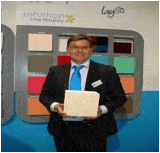
Radium Foam, a division of the Vita Group in Maastricht, Holland, unveiled Intuition latex at Interzum Cologne. Vita General Manager Cees Zielman shows off a block of the product, which contains phase change materials
Interest in latex cores and comfort layers continues to grow, latex suppliers say. In some respects, product trends in the category mirror those in polyurethane foams. Sales of solid latex cores are increasing and latex with extra ingredients and new treatments are being brought to market.
According to Latex International’s Tom Eisenberg, the all–latex mattress is a significant trend in the industry. Sales of latex rolls for layering into hybrid mattresses continue to be strong, but a growing number of manufacturers are interested in building solid latex beds.
“The all–latex bed provides a way for a regional manufacturer to improve margins and compete for space on the retail sales floor with all those memory foam beds,” says Eisenberg, vice president of strategic marketing for the Shelton, Conn.–based company. “We are providing a finished product for some customers in 7–, 9– and 11–inch heights. We bond the cores and provide the FR layer and zipper cover.”
“Typically, you achieve different feels by layering a few inches of three different comfort levels together, with the plushest latex on top,” Eisenberg explains. Latex International offers latex in eight firmnesses.
When it comes to working with customers, Sapsa Latex, a Dunlop latex producer based in Paris, prides itself on being flexible and having the ability to meet diverse customer needs, says Grégoire Moll, director of sales and marketing.
“We make the à la carte possible and can do whatever you want, especially with our breakthrough multifoaming technology, which allows us to pour different foams at once without the use of glues,” he says.
Sapsa showcased a new construction at Interzum. It has engineered a hybrid latex and polyurethane core in which latex is poured around “rods” of polyurethane foam of differing densities. The result is a zoned core with a unique support system.
Sapsa formulates everything from 100% natural latex to 100% synthetic latex. Its latex blends are either 85% natural and 15% synthetic or 80% synthetic and 20% natural.
Worldwide demand for foam marketed as 100% pure latex made entirely from the sap of the Hevea brasiliensis rubber tree continues to grow each year, latex suppliers say. But the product remains a niche used primarily in high–end “organic” mattresses. Most of the latex sold around the world is a blend of synthetic and natural rubber.
Latex International received a U.S. patent in September 2010 for its Celsion latex, which incorporates phase change material during the foam vulcanization process to provide temperature regulation for sleepers. (Phase change materials are organic and inorganic compounds that store and release heat as they melt and solidify at certain temperatures.) Celsion is currently available in pillows, finished toppers and comfort layers.
Latexco, based in Tielt, Belgium, recently introduced Theta Comfort latex. And Radium Foam, the latex foam division of the Vita Group in Maastricht, Holland, now offers Intuition latex. Both products contain phase change materials.
Latexco’s Theta Comfort is a topical coating of “phase change microcapsules” and is available to manufacturers worldwide. Radium Foam’s Intuition has phase change material incorporated during the vulcanization process and is available to non–U.S. manufacturers.
Latexco, Sapsa and Radium Foam all have brought out products that incorporate fire–retardant technology. They are said to meet a range of mattress component ignition tests enacted by the European Union and its member countries. In the United States, these products would assist in complying with current open–flame standards, but wouldn’t take the place of the required fire barrier on a finished mattress set.
For instance, Latexco’s product, called simply “Fire Retardant,” is said to meet the European Standard EN597–1 smoldering cigarette; EN597–2 match flame equivalent; U.K. Standard BS 5852 source 2, match flame; and Italian Standard UN19175 for fire retardant products.
Innersprings reach new highs, and lows
The majority of innerspring innovations are coming in Marshall coils, as more and more mattress makers turn to the spring to solve problems and add panache to beds at a broader range of price points.
Spring suppliers are offering more affordable coil units that use less wire and have fewer coils with wider diameters. There are wrapped coils that rise to dizzying heights, as well as those that reach new lows at barely an inch tall.
Marshall coils, a type of encased coil, were once a component saved for high–end mattresses, says Martin Wolfson, president of Texas Pocket Springs in Cleburne, Texas.
“In 2010, we rolled out a unit with a 660–coil count in queen—instead of the standard 884 coils,” he says. “The product has gotten a great reception because it allows wrapped coils to go into mid–priced beds.”
“The news in innersprings is definitely in wrapped coils,” says Erol Boydak, general manager of Boyçelik, a springs supplier based in Kayseri, Turkey. “They are our biggest growth area in every market. In the last two years, we have experienced about a 25% increase in production of these coils.”
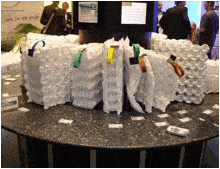
Mattress makers can find springs in almost any height. Starsprings, based in Herrljunga, Sweden, showed off its selection during Interzum Cologne in Cologne, Germany, in May.
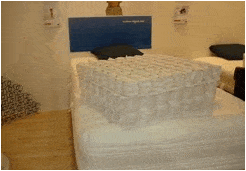
Agro, which has headquarters in Bad Essen, Germany, offers double–decker coils encased with nonwoven fabric.
Can you take me higher?
A coil in a traditional LFK or Bonnell unit will top out at about 7 inches, suppliers say, but encased coils are growing taller by the year. Some suppliers push them higher by bonding springs together in taller and taller units.
In addition to offering its high–end LFK Cosiflex unit, which has no knots and can be zoned with different wire gauges and alternating–turn coils, springs supplier Subiñas is accelerating production of taller, improved Marshall coils in a variety of wire gauges.
The taller coils help manufacturers save money on expensive upholstery layers, says Javier Subiñas, president of the Vizcaya, Spain–based company.
“This product could become the main unit in bedding usage in the future,” he says. “Individually wrapped coils prevent partner disturbance from tossing and turning and give the mattress a consistent feel and comfort.”
Hickory Springs Mfg. Co. in Hickory, N.C., is ramping up production on a manufacturing line for 10–inch coils. Texas Pocket Springs, which already offers 8– and 9–inch springs also is working on a 10–inch tall unit.
“A couple of years ago, most units were 4 to 6 inches,” Wolfson says. “Then we went to 7 and 8 inches. Now we’re going to 10. Our patented Quad–Coil module technology keeps those springs upright and prevents leaning or swaying.”
Agro, a spring producer based in Bad Essen, Germany, achieves height by layering. It offers Marshall coils bonded with adhesive to nonwoven fabric that is sandwiched between the layers and again on the top and bottom of the unit. The result is height with dimensional stability. The company also recently updated its spring–within–a–spring “nested” coils. The new Body2Sense Marshall coils are re–engineered to be completely silent.
Early this year, Leggett & Platt in Carthage, Mo., rebranded its entire collection of Marshall coils under the Comfort Core umbrella as part of a new focus on the coil, says Mark Quinn, L&P segment vice president of marketing.
“We’re investing significant time and resources in R&D for the Comfort Core lines and are looking to innovate even more configurations and constructions,” Quinn says. “We want to continue to be a leader in giving manufacturers more options for creating the ultimate comfort in a sleep system.”
How low can you go?
Microcoils were introduced into mattresses about five years ago, suppliers say. Made with finer wire, they are designed to replace or enhance high–end foams in the mattress’ comfort layers. They typically range from 2∂ inches to 4∂ inches tall.
L&P offers the 2.4–inch Marshall coil Softech. Marketing materials promote it as an alternative to foams, saying it’s less expensive and 28% cooler to sleep on. The company cites Rollator tests that found the Softech coil maintained its support longer than visco–elastic and polyurethane foams that were tested.
“Our microcoils are 2.5, 3.5 and 4.5 inches high and made from fine wire that never takes a set,” Wolfson says. “There are 1,344 coils in a queen size and we try to replicate the feel of visco and latex. It’s less expensive than a slab of foam and it’s cooler. These allow the air to move through the underlay.”
Then there are “ultra microcoils”—fine and delicate enough to replace high–end foams in a bed’s top upholstery layer.
Starsprings, which is based in Herrljunga, Sweden, has patented Stretch Pocket, which stretches in both directions and is just under 1∂ inches tall. It’s designed for pillow–top mattresses and toppers.
Hickory Springs now stocks and sells ultra microcoils manufactured by the company’s U.K. partner, Spinks Springs. Posturfil is 1∂ inches tall and has more than 1,000 coils in queen size. HD is a three–quarter inch spring unit with more than 2,000 coils in a queen.
“You can find them in beds priced at $1,000 and up,” says Rick Anthony, Hickory Springs director of sales for bedding products. “When you bring an innerspring closer to the sleep surface, it performs like an innerspring yet doesn’t sacrifice comfort.”
Starsprings’ new Unipocket is marketed as “a unique product with unique properties.” The fabric cover on each coil has carefully situated slits that add to the stretch, flexibility and ventilation of the mattress. Unipocket is engineered to be quieter than other coils and is available with zoning, according to the company.
Low–profile innersprings are helping mattress makers battle the ubiquitous body impression problem and springs suppliers proudly extol the virtues of their product in preventing this cause of so many mattress returns.
“We are all charged with making sure our mattress products don’t come back due to body impressions,” Quinn says. “We say fill the space in your comfort layer with Softech. Use the coil as an upholstery material. The great thing about innersprings is that you build the comfort into the bed—you don’t need to build big, thick 17–inch mattresses to do that.”
“I do believe we’ve reached our limit on mattress heights and am wondering when the more European profile will return to the United States, with mattress heights being 12 to 14 inches, maximum,” Anthony says.

Leggett & Platt in Carthage, Mo., offers the 2.4–inch Marshall coil Softech, which it promotes as an alternative to foams.
New fabric features
Suppliers also are innovating when it comes to the fabrics wrapping all of these coils.
Starsprings offers Enviro, a nonwoven fabric available on all of its wrapped coils that is derived from a renewable resource, cornstarch. Enviro, which contains no petrochemical products, is
recyclable and biodegradable.
Hickory Springs is working on a fabric for its Marshall coils that’s made from organic cotton. It hopes to offer it by year–end.
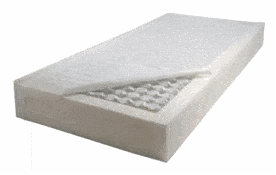
Subiñas, a springs supplier in Vizcaya, Spain, is among the many companies accelerating production of encased coils to meet mattress makers’ demand for the product
Other news on the wire
There is news in traditional, unwrapped innersprings, too.
Last year, L&P launched VertiCoil Edge, a traditional innerspring with 20% more coils than the typical unit.
At Interzum Cologne in Cologne, Germany, in May, Agro rolled out the Coilstar unit designed for adjustable bases. From a distance, it looks like a traditional innerspring, but when placed on a motion base, the hinged unit is able to bend either up or down at every coil row.
Hickory Springs recently unveiled new InCheX technology in its ultra–high coil count InnerACT innerspring. The patented process can be applied to any Hickory Springs innerspring. The process increases sleep–surface stability by allowing alternating left– and right–turn coils to be placed in a checkerboard pattern.
Innerspring producers are increasingly “in the zone.”
“In the last four years, we’ve seen the use of zoned coils rise from about 10% of our production to 60%,” Wolfson says.
Several spring producers noted a resurgence in wire foundations in place of the ubiquitous all–wood buildups.
“There were noise and quality issues in all–wood foundations,” Anthony says. “We are seeing a return to wire–stack ‘working’ foundations since about last year.”
Sorting it all out for mattress makers
In fact, there is so much new technology and product lines have become so complex that some suppliers have stepped up the level of design assistance they offer mattress makers.
In the design center at its headquarters, Starsprings guides customers through the process of creating multilayered innerspring beds.
“We are not the largest innerspring company in the world, but we try to be the most flexible, creative and helpful,” says Johan Dahlin, Starsprings sales and marketing manager. “Our automotive industry R&D has helped us to develop new technology for beds. And we try to inspire our customers to think in new ways.”
Agro has an enormous selection of spring units and coil types. Its new “Construction Kit” for customers helps reduce the complexity by narrowing choices and guiding new customers through the mattress design process. N
Main types of mattress innersprings
Bonnell A knotted, round–top, hourglass–shaped steel wire coil. When laced together with cross wire helicals, these coils form the simplest innerspring unit.
LFK An unknotted offset coil with a cylindrical or columnar shape.
Marshall A type of innerspring construction in which thin gauge, barrel–shaped, knotless coils are encased in fabric pockets. Also known as “pocketed” or encased coils.
Source: International Sleep Products Association glossary
Gel easing its way into sleep products
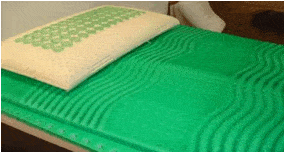
Latexco is offering latex pillows and upholstery layers for mattresses topped with green Oxygel. Its ‘pinhole perforations allow for perfect ventilation,’ the Tielt, Belgium–based company says.
Any way you cut, contour or mix it, gels are garnering attention in the mattress industry. At Interzum Cologne in Cologne, Germany, in May, Latexco unveiled latex pillows and upholstery layers for mattresses topped with green Oxygel. The gel creates “the perfect natural microclimate and optimal pressure relief” while “pinhole perforations allow for perfect ventilation,” according to the latex foam supplier, which has headquarters in Tielt, Belgium.
In 2009, Natura World, a mattress and accessories maker in Cambridge, Ontario, licensed the rights to manufacture and market NexGel, the honeycomb–like, “buckling” gel developed by EdiZONE in Salt Lake City.
A year ago, Natura formed GelSolutions, based in Wichita Falls, Texas, to manufacture and market NexGel to the mattress industry.
“Gel is the future of where bedding is going,” says David Malpas, GelSolutions executive vice president of sales. “We introduced the product to Australia, where it has gained tremendous acceptance, and interest among U.S. manufacturers is growing.”
GelSolutions has introduced new profiles, configurations and formulations of NexGel.
“We continue to innovate,” Malpas says.
Most of the gels available for use in mattresses today originally were developed for medical settings to prevent or alleviate decubitus ulcers (or pressure sores) among bedridden patients. In consumer applications, they are touted for those same comfort and pressure–relieving properties.
While NexGel is a honeycomb, other mattresses contain a more liquid–like gel. Akton visco–elastic polymer, a gel developed by Actions Products Inc. in Hagerstown, Md., has made its way into some commercial mattresses.
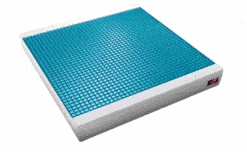
Like other gel products, Technogel’s Dr. Scholl’s–branded version is touted for its pressure relief properties. In mattresses, Technogel’s raised–grid product is combined with engineered foam cores manufactured by Carpenter Co. in Richmond, Va.
A new gel product, available as finished mattresses and pillows to U.S. retailers, is from Technogel GmbH, an Italian and German company with U.S. headquarters in Pittsburgh.
Technogel’s Dr. Scholl’s–branded gel is in a raised grid and combined with engineered foam cores manufactured by Carpenter Co., says Bob Steelman, vice president of sales and marketing for the Richmond, Va.–based foam supplier.
“There has been a lot of talk in the industry about gel lately. We offer an enhanced memory foam blended with gel beads,” he says.
Perhaps the most significant gel introduction to date has been Serta’s iComfort all–foam bed that has a top comfort layer of foam with gel beads mixed into the foam before it’s poured. Serta calls it “gel–infused memory foam.” The Hoffman Estates, Ill.–based mattress maker introduced it in January.
Such new beds have stimulated interest among other bedding manufacturers in offering mattresses with a gel component in the comfort layer of the bed, foam suppliers told BedTimes. They expect to see new foam–and–gel formulas to come to market by year–end.
FIND SUPPLIERS
To locate suppliers for foams, springs or gels, check the online BedTimes Supplies Guide. It’s the industry’s most comprehensive directory of machinery, equipment, components, supplies and services. A print version of the guide is published every December in BedTimes.




